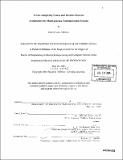A low-complexity linear and iterative receiver architecture for multi-antenna communication systems
Author(s)
Milliner, David Louis, 1981-
DownloadFull printable version (2.405Mb)
Other Contributors
Massachusetts Institute of Technology. Dept. of Electrical Engineering and Computer Science.
Advisor
Manish Goel and Moe Win.
Terms of use
Metadata
Show full item recordAbstract
Multi-antenna systems have been shown to significantly improve channel capacity in wireless environments. The focus of this thesis is on the design of low-complexity multi-antenna receiver architectures for communication networks and their demonstration in a real-time wireless environment. Our practical realization of an orthogonal frequency-division multi-antenna receiver is capable of several forms of linear and iterative detection. Our implementation is based on a division-free reformulation of standard minimum mean-squared-error detection algorithms and uses complex dot-products as the basic building blocks of a folded-pipelined architecture. This folded-pipelined architecture provides significant area savings over non-folded approaches. The demonstration of our receiver architecture is carried out on a rapid-prototyping FPGA communication system. This prototype is used to validate our design and complement theoretical and simulated results with real-time laboratory measurements in a typical office environment.
Description
Thesis (M. Eng.)--Massachusetts Institute of Technology, Dept. of Electrical Engineering and Computer Science, 2004. Vita. Includes bibliographical references (leaves 60-62).
Date issued
2004Department
Massachusetts Institute of Technology. Department of Electrical Engineering and Computer SciencePublisher
Massachusetts Institute of Technology
Keywords
Electrical Engineering and Computer Science.